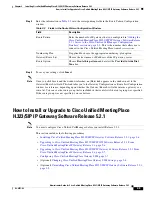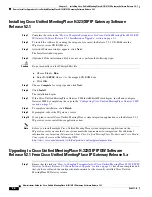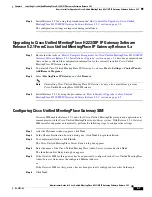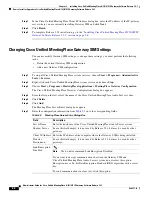
1-5
Administrator Guide for Cisco Unified MeetingPlace H.323/SIP IP Gateway Software Release 5.2.1
OL-6571-02
Chapter 1 Introducing Cisco Unified MeetingPlace H.323/SIP IP Gateway Software Release 5.2.1
Information About Cisco Unified MeetingPlace H.323/SIP IP Gateway Software Release 5.2.1 Components
Protocols That Cisco Unified MeetingPlace H.323/SIP IP Gateway Software Release 5.2.1 Uses
Protocols are rules that endpoints follow for sending and receiving messages, checking errors, and
compressing data. Release 5.2.1 uses the following protocols to transmit data throughout the
Cisco Unified MeetingPlace system:
Dual Tone Multi-Frequency Support by Cisco Unified MeetingPlace H.323/SIP IP Gateway Software
Release 5.2.1
Dual Tone Multi-Frequency (DTMF) is a signaling method that allocates a specific pair of frequencies
to each key on a touch-tone telephone. Various Cisco Unified MeetingPlace Audio Server system
functions are invoked when callers press touch-tone keys in certain combinations. For example, the #5
key combination enables callers to mute and unmute their phones during a meeting.
PSTN phones use in-band DTMF, which embeds the tone in the audio stream. Although in-band DTMF
is efficient, it cannot carry DTMF signals reliably when a voice compression codec is used.
Protocol
Description
H.323
The protocol that is responsible for communication between
Cisco Unified CallManager and Release 5.2.1. The protocol suite,
which extends H.225 for call signaling and H.245 for data transfer, is
used in the successful acceptance and media exchange of data.
Session Initiation Protocol
(SIP)
A call-control protocol that supports all existing functionality that is
available to a Cisco IP phone. Release 5.2.1 complies with RFC 3261
and RFC 3515 specifications and interoperates with the following
endpoints:
•
Cisco SIP Proxy Server environment
•
Cisco 7960 and Cisco 7940 SIP IP phones
•
Cisco IP/Videoconferencing Multipoint Control Unit
(IP/VC MCU)
•
Microsoft Real-Time Communications (RTC) Server for
integration with Windows XP Messenger
Real-Time Transport
Protocol (RTP)
An Internet protocol responsible for the transmission of real-time data,
such as video and audio. Generally, RTP runs on top of User Datagram
Protocol (UDP) but can also be supported by other transport protocols.
For Release 5.2.1, RTP is responsible for carrying the G.711 and
G.729a encoded data. G.711 is a standard 64 kbps codec, and G.729a is
an 8 kbps codec. Both codecs offer quality audio transmission over
high-speed connections.
Skinny Station Protocol
(SSP)
A protocol that is used to establish connections, locate resources,
forward data, and handle flow control and error recovery, which enable
a Cisco IP phone to notify Cisco Unified CallManager of its ability to
place and receive calls.
Cisco Unified MeetingPlace
Gateway System Integrity
Manager (SIM)
A messaging service that enables NT services on the IP-gateway server
to communicate directly with the Cisco Unified MeetingPlace system.












































